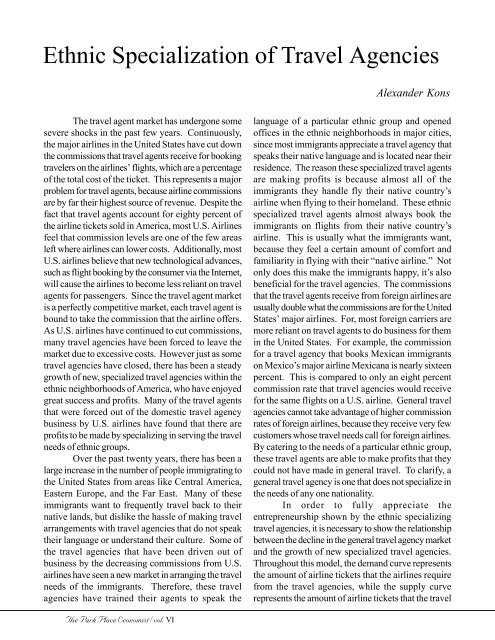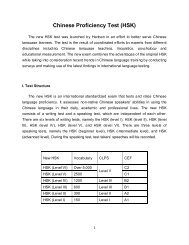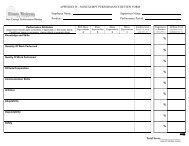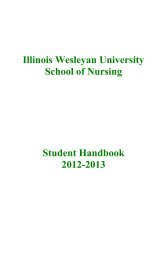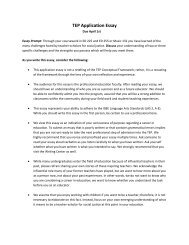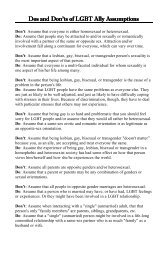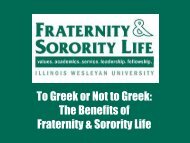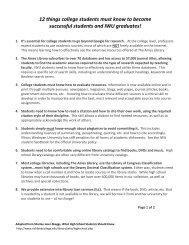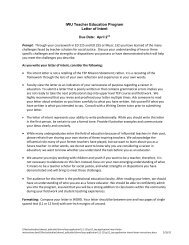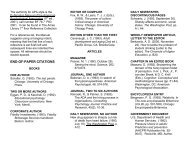Ethnic Specialization of Travel Agencies
Ethnic Specialization of Travel Agencies
Ethnic Specialization of Travel Agencies
Create successful ePaper yourself
Turn your PDF publications into a flip-book with our unique Google optimized e-Paper software.
<strong>Ethnic</strong> <strong>Specialization</strong> <strong>of</strong> <strong>Travel</strong> <strong>Agencies</strong><br />
Alexander Kons<br />
The travel agent market has undergone some<br />
severe shocks in the past few years. Continuously,<br />
the major airlines in the United States have cut down<br />
the commissions that travel agents receive for booking<br />
travelers on the airlines’ flights, which are a percentage<br />
<strong>of</strong> the total cost <strong>of</strong> the ticket. This represents a major<br />
problem for travel agents, because airline commissions<br />
are by far their highest source <strong>of</strong> revenue. Despite the<br />
fact that travel agents account for eighty percent <strong>of</strong><br />
the airline tickets sold in America, most U.S. Airlines<br />
feel that commission levels are one <strong>of</strong> the few areas<br />
left where airlines can lower costs. Additionally, most<br />
U.S. airlines believe that new technological advances,<br />
such as flight booking by the consumer via the Internet,<br />
will cause the airlines to become less reliant on travel<br />
agents for passengers. Since the travel agent market<br />
is a perfectly competitive market, each travel agent is<br />
bound to take the commission that the airline <strong>of</strong>fers.<br />
As U.S. airlines have continued to cut commissions,<br />
many travel agencies have been forced to leave the<br />
market due to excessive costs. However just as some<br />
travel agencies have closed, there has been a steady<br />
growth <strong>of</strong> new, specialized travel agencies within the<br />
ethnic neighborhoods <strong>of</strong> America, who have enjoyed<br />
great success and pr<strong>of</strong>its. Many <strong>of</strong> the travel agents<br />
that were forced out <strong>of</strong> the domestic travel agency<br />
business by U.S. airlines have found that there are<br />
pr<strong>of</strong>its to be made by specializing in serving the travel<br />
needs <strong>of</strong> ethnic groups.<br />
Over the past twenty years, there has been a<br />
large increase in the number <strong>of</strong> people immigrating to<br />
the United States from areas like Central America,<br />
Eastern Europe, and the Far East. Many <strong>of</strong> these<br />
immigrants want to frequently travel back to their<br />
native lands, but dislike the hassle <strong>of</strong> making travel<br />
arrangements with travel agencies that do not speak<br />
their language or understand their culture. Some <strong>of</strong><br />
the travel agencies that have been driven out <strong>of</strong><br />
business by the decreasing commissions from U.S.<br />
airlines have seen a new market in arranging the travel<br />
needs <strong>of</strong> the immigrants. Therefore, these travel<br />
agencies have trained their agents to speak the<br />
language <strong>of</strong> a particular ethnic group and opened<br />
<strong>of</strong>fices in the ethnic neighborhoods in major cities,<br />
since most immigrants appreciate a travel agency that<br />
speaks their native language and is located near their<br />
residence. The reason these specialized travel agents<br />
are making pr<strong>of</strong>its is because almost all <strong>of</strong> the<br />
immigrants they handle fly their native country’s<br />
airline when flying to their homeland. These ethnic<br />
specialized travel agents almost always book the<br />
immigrants on flights from their native country’s<br />
airline. This is usually what the immigrants want,<br />
because they feel a certain amount <strong>of</strong> comfort and<br />
familiarity in flying with their “native airline.” Not<br />
only does this make the immigrants happy, it’s also<br />
beneficial for the travel agencies. The commissions<br />
that the travel agents receive from foreign airlines are<br />
usually double what the commissions are for the United<br />
States’ major airlines. For, most foreign carriers are<br />
more reliant on travel agents to do business for them<br />
in the United States. For example, the commission<br />
for a travel agency that books Mexican immigrants<br />
on Mexico’s major airline Mexicana is nearly sixteen<br />
percent. This is compared to only an eight percent<br />
commission rate that travel agencies would receive<br />
for the same flights on a U.S. airline. General travel<br />
agencies cannot take advantage <strong>of</strong> higher commission<br />
rates <strong>of</strong> foreign airlines, because they receive very few<br />
customers whose travel needs call for foreign airlines.<br />
By catering to the needs <strong>of</strong> a particular ethnic group,<br />
these travel agents are able to make pr<strong>of</strong>its that they<br />
could not have made in general travel. To clarify, a<br />
general travel agency is one that does not specialize in<br />
the needs <strong>of</strong> any one nationality.<br />
In order to fully appreciate the<br />
entrepreneurship shown by the ethnic specializing<br />
travel agencies, it is necessary to show the relationship<br />
between the decline in the general travel agency market<br />
and the growth <strong>of</strong> new specialized travel agencies.<br />
Throughout this model, the demand curve represents<br />
the amount <strong>of</strong> airline tickets that the airlines require<br />
from the travel agencies, while the supply curve<br />
represents the amount <strong>of</strong> airline tickets that the travel<br />
The Park Place Economist / vol. VI
Kons<br />
agencies supply to the airlines. Therefore, price is<br />
actually the commission level that the airlines are<br />
willing to <strong>of</strong>fer to the travel agencies. Also, consider<br />
the average costs <strong>of</strong> a specialized and non-specialized<br />
agency to be equivalent. Graph One shows the demand<br />
and supply curve for the entire general travel agency<br />
market at a commission level <strong>of</strong> ten percent, while<br />
so it is making a normal pr<strong>of</strong>it. At a commission level<br />
<strong>of</strong> ten percent, the general travel agency market is at<br />
equilibrium for a perfectly competitive market.<br />
Now it is announced that the U.S. airlines have<br />
decided to cut the travel agents’ commissions down to<br />
eight percent. The airlines feel that they are less reliant<br />
on travel agencies to get passengers, so they reduce<br />
General <strong>Travel</strong> Agency at Equlibrium: Commission Level 10%<br />
Commission<br />
Level (price)<br />
Graph One: Market<br />
S<br />
Commission<br />
Level<br />
Graph Two: Individual Firm<br />
MC 1<br />
AC<br />
C 1<br />
c<br />
A<br />
1<br />
B<br />
DMR 1<br />
D<br />
Q 1<br />
Tickets for Airlines (quantity)<br />
Tickets for Airlines<br />
Shake-up in General <strong>Travel</strong> Agency Market: Commission Levels Change from 10% to 8%<br />
q 1<br />
MC 1<br />
AC<br />
Commission<br />
Level<br />
C 1<br />
C 2<br />
Graph Three: Market<br />
C<br />
A<br />
Q 2<br />
Q 1<br />
Tickets for Airlines<br />
Graph Four: Individual Firm<br />
S<br />
Commission<br />
Level<br />
12345678901234<br />
12345678901234<br />
c 1 R 12345678901234<br />
c 1<br />
B<br />
2 D<br />
D 2<br />
D 1<br />
q 1<br />
DMR 1<br />
DMR 2<br />
q 2<br />
Tickets for Airlines<br />
Graph Two shows the individual costs and revenue<br />
curves <strong>of</strong> a particular general travel agency. The<br />
equilibrium market commission level (C 1<br />
) and number<br />
<strong>of</strong> tickets supplied to the airlines (Q 1<br />
) is shown on<br />
Graph 1 at point A. Since this market is perfectly<br />
competitive, each travel agency is a price taker and<br />
must take the commission level at C 1<br />
, which again is<br />
ten percent. Therefore, the individual firms demand<br />
curve is DMR 1<br />
and commission level is c 1<br />
. Since an<br />
individual firm produces at the point where the<br />
marginal revenue curve (DMR 1<br />
) intersects the<br />
marginal cost curve (MC 1<br />
), the travel agency supplies<br />
the number tickets at q 1<br />
. At the commission and output<br />
level <strong>of</strong> B, the travel agency can cover its average costs,<br />
their commission or demand for travel agencies’<br />
services. Graph’s Three and Four demonstrate the<br />
effect that the decrease in commissions has on the<br />
general travel agency market. First the demand curve<br />
shifts from D 1<br />
to D 2<br />
, which shows the immediate effect<br />
<strong>of</strong> the change <strong>of</strong> commission level. As a result, the<br />
market’s new equilibrium point is now C. Therefore,<br />
the individual firm’s marginal revenue and demand<br />
curve shifts down from DMR 1<br />
to DMR 2<br />
on Graph Four<br />
as commission levels move from c 1<br />
to c 2<br />
. This new<br />
equilibrium point at point D does not allow the<br />
individual firm to cover its average costs, so the firm<br />
is no longer making a normal pr<strong>of</strong>it. The loss <strong>of</strong> pr<strong>of</strong>it<br />
is shown by Area R 1<br />
on Graph Four. Essentially, the<br />
The Park Place Economist / vol. VI
<strong>Ethnic</strong> <strong>Specialization</strong> <strong>of</strong> Travewl <strong>Agencies</strong><br />
new commission level will force many travel agencies<br />
to leave the general travel agent market. Normally<br />
the exit <strong>of</strong> firms would cause the market supply curve<br />
to shift to the upper left, which should bring<br />
commission levels back to ten percent. This case is<br />
different, because unlike conventional economics the<br />
consumers (airlines) have direct control over what<br />
travel agency market. Since the agents <strong>of</strong> this firm<br />
have invested many years <strong>of</strong> education and experience<br />
in the travel business, they would prefer to find a new<br />
market where their current education and skills as<br />
travel agents can be maximized. If the firm is able to<br />
discover the opportunity that exists in serving the travel<br />
needs <strong>of</strong> ethnic groups and utilizing the higher<br />
Market for Specialized <strong>Travel</strong> Agency: Commission Level 16% from LOT<br />
Commission<br />
Level<br />
Graph Five: Market (Polish Immigrants)<br />
S 1<br />
D 3<br />
Commission<br />
Level<br />
C 3<br />
c 3<br />
Commission<br />
Level<br />
Graph Six: Individual Firm<br />
MC<br />
AC<br />
Q 3<br />
Tickets for LOT<br />
123456789012345678<br />
123456789012345678<br />
123456789012345678<br />
Tickets for LOT<br />
Future <strong>of</strong> Specialized <strong>Travel</strong> <strong>Agencies</strong><br />
Graph Seven: Short Run<br />
Graph Eight: Long Run<br />
Commission Rate Finally Falls<br />
Commission<br />
S 4 Level<br />
S 2<br />
S 3<br />
S 4<br />
C 3 D c<br />
4 3<br />
S S 2 3<br />
c 4 D<br />
Q 4<br />
Q 5<br />
Q q q 5<br />
6 5 6<br />
Tickets for Foreign Airlines<br />
Tickets for Airlines<br />
q 4<br />
R 2<br />
q 3<br />
DMR 3<br />
prices (commission level) they want charged. Since<br />
the airlines believe they will be less reliant on travel<br />
agencies, it is unlikely that the airlines will raise<br />
commission levels because the number <strong>of</strong> general<br />
travel agencies is shrinking. It is quite possible that<br />
the market demand curve may become a straight line<br />
and the number <strong>of</strong> travel agents left in the market will<br />
not influence commission levels. Therefore, the only<br />
way for general travel agencies to make a normal pr<strong>of</strong>it<br />
is by finding ways to reduce their average costs. This<br />
is exactly what the airlines hope will happen. As long<br />
as travel agents rely on U.S. airlines for commissions,<br />
they will struggle to make pr<strong>of</strong>its.<br />
Consider a firm who has just left the general<br />
commission rates <strong>of</strong> foreign airlines, then these people<br />
have found a way to maximize their skills. Graph’s<br />
Five and Six reveal the opportunity that lies in the<br />
specialized travel agency market. Graph Five shows<br />
the market demand and supply curves for specialized<br />
travel agencies dealing with the travel needs. The<br />
commissions rate that travel agencies receives from<br />
the Polish national airline, LOT, is approximately<br />
sixteen percent (C 3<br />
) and the quantity supplied by travel<br />
agencies at this commission level is Q 3<br />
. Since this<br />
market is also perfectly competitive, the individual<br />
specialized travel agency must take the commission<br />
level <strong>of</strong> sixteen percent. Therefore, the marginal<br />
revenue and demand curve for an individual firm is<br />
The Park Place Economist / vol. VI
Kons<br />
DMR 3<br />
on Graph Six. The commission level for the<br />
individual firm is c 3<br />
and the number <strong>of</strong> tickets supplied<br />
to LOT is q 3<br />
. Immediately it can be seen in Area R 2<br />
that the individual firm will make an excess pr<strong>of</strong>it in<br />
this market. The firm that attracts the business <strong>of</strong><br />
individual ethnic groups is able to acquire excess<br />
pr<strong>of</strong>its, if it utilizes the higher commission levels <strong>of</strong><br />
foreign carriers. As long as foreign carriers continue<br />
to <strong>of</strong>fer significantly higher commission levels then<br />
U.S. airlines, specialized travel agencies will make<br />
much higher pr<strong>of</strong>its then general travel agencies.<br />
These high pr<strong>of</strong>its are made as a result <strong>of</strong> very little<br />
investment required by the firms to enter the<br />
specialized travel agency market. These specialized<br />
travel agencies were able to see an opportunity in a<br />
new market and have enjoyed great success.<br />
Many travel agents wonder what the future<br />
holds for the specialized travel agency market. Since<br />
the specialized travel agency market is perfectly competitive,<br />
it is likely that more former general travel<br />
agencies will enter the market in order to receive the<br />
excess pr<strong>of</strong>its that current firms are enjoying. In perfectly<br />
competitive industries, when the firms are enjoying<br />
excess pr<strong>of</strong>it, new firms enter the market and<br />
drive prices down to the point where each firm makes<br />
a normal pr<strong>of</strong>it. However, this may not be the immediate<br />
case in the specialized travel agency market.<br />
How long specialized travel agencies make excess<br />
pr<strong>of</strong>its all depends on how fast foreign airlines adjust<br />
the commission level to the number <strong>of</strong> suppliers in the<br />
market. Changing commission levels is a long-term<br />
decision, thus in the short run commission levels remain<br />
high. In the short run, the demand curve would<br />
be essentially a straight line as shown in Graph Seven<br />
by line D 4<br />
. No matter how many travel agencies enter<br />
the market in the short run, the foreign airlines are<br />
unable to adjust their commission levels. Therefore,<br />
the entry <strong>of</strong> new firms into the market merely increases<br />
the number <strong>of</strong> tickets supplied to foreign airlines in<br />
the short run (i.e. Q 4<br />
-Q 5<br />
-Q 6<br />
). However, in the long<br />
run the foreign airlines will find that they are unable<br />
to lower commission levels to a percentage that is more<br />
equivalent to the number <strong>of</strong> firms in the market. This<br />
causes the equilibrium price to change from C 3<br />
to C 4<br />
on Graph Eight. Thus in the long run, specialized<br />
travel agencies will tend to come closer to making a<br />
normal pr<strong>of</strong>it. If the commission levels start to approach<br />
the commission levels <strong>of</strong> U.S. airlines, then<br />
firms will start to leave the travel agency industry all<br />
together. The changes that the travel market is undergoing<br />
are quite remarkable. Cost cutting maneuvers<br />
and technology is pressuring to replace the travel agent,<br />
which has forced many travel agents to find more creative<br />
ways <strong>of</strong> providing their service to travelers and<br />
operating a pr<strong>of</strong>itable business.<br />
The Park Place Economist / vol. VI


